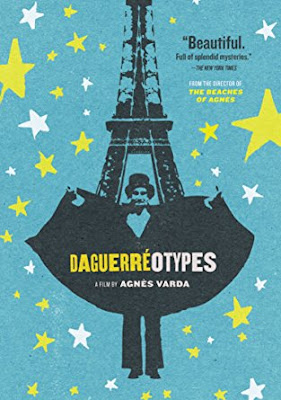Daguerreotypes
1976 slice-of-life documentary
Rating: 16/20
Plot: Director Agnes Varda films various shopkeepers and a visiting magician near her home.
I have to catch up with both Agnes Varda and her late husband Jacques Demy, especially since I've never seen a movie by either of them that I didn't love. This slice-of-life documentary about people running or frequenting butcher shops, perfume shops, driving schools, and shops that appear to sell nothing but accordions and metronomes wasn't doing much for me initially, but once I fell under its spell and its unique rhythm, I really connected with it. Varda's documentaries are always very personal, and here, she's just decided that these ordinary people who she sees all the time when she's out and about deserve their own movie. With Daguerreotypes, she's created art from the most seemingly mundane people and places, and by the end, it's become impossible to argue that she's wrong.
Varda juxtaposes shots of this traveling cheesy, loquacious magician eating fire, sticking knives into a lady's boxed head, and multiplying bank notes and rice with shots of these shopkeepers doing their jobs. So the magician abracadabraing with money is shown with people paying for things in the shops, a disturbing trick where the magician stabs his forearm with a large knife is mixed in with a butcher doing his work, and the part of the show where he's playing with fire and spliced with a guy making bread in a bakery. Varda's idea is that these ordinary people create everyday magic, that these people who just live to make bread, sell their wares, or teach people how to pass a driving test also make the world a more enchanting place. Maybe that's why the people assembled to watch this magician's three-hour show look so bored in some shots. They're all used to seeing magic every single day.
Whoever operates the camera for this thing is a natural at knowing exactly where it needs to be. There are several instances where we'll be focusing on one character before a passer-by catches the camera's eye and causes it to leave that first subject to follow the new person for a bit. Other times, the camera will swivel from a customer buying something to a new character walking in or a child saying something or whatever, and at times, it's almost too perfect, like the whole thing has been staged. I know that can't be the case, however, because a documentarian isn't allowed to stage things. It's in the code.
There are a few great scenes, but one of those that just seems so set up really caught my attention. The magician has put a small chalkboard in a newspaper and given it to a woman who you see in a mirror behind the performer. Then, there's this shot of her with a Mona Lisa behind her, and I swear, the two have matching facial expressions. All of this is to the "Ride of the Valkyries," one of the few moments in this that has music that isn't played on an accordion. Then, it shifts to shots of an ice skater who might be the same woman who sort of looks like the Mona Lisa, and suddenly, the accordion is back.
I don't remember what the magician's trick was exactly. I know that Agnes Varda's trick wowed me though.
My favorite of this cast of characters is probably the old woman who owns the perfume shop with her husband. She barely says a word, reluctant even to say her own name at one point, but her face is so expressive. And there's this smile she gives the camera when her husband introduces here, right after she's quietly said her own name, that melted my heart.
This ends with the subjects being asked about their dreams. Some of them say they're too busy to dream, some dream of the places they've come from, one guy dreams about pretty women who have come into his place of business. Most, however, dream about work. I'm not sure if that's comforting or if that's something else--that idea that these are people who are living their dreams and dreaming their lives. I think I'm leaning toward comforting.
Anyway, I'm glad that Agnes Varda knew these people deserved to occupy a movie.
Please note that you might have to have a high tolerance for the accordion if you decide to check this out.
Subscribe to:
Post Comments (Atom)


No comments:
Post a Comment